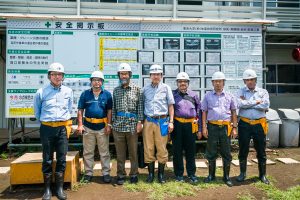Collaboration Partners
The fundamental functions of a university are to acquire, to conserve and to disseminate the knowledge for the general betterment. The problems that we face to maintain these functions or even the paths that we follow are sometimes become much difficult for an individual. An effective cooperation between the minds of people of same flock or the institutions may make the problem easier for us to solve. We are looking forward to know those people or institutions across the world who can put some synchronized steps with us.Current Partners
Saitama University, Japan
The Department of Civil and Environmental Engineering of Saitama University has a graduate program for international students. The program offers highly qualified individuals opportunities to pursue graduate studies and research in the field of civil and environmental engineering. The fields of study include Infrastructure Management, Transportation Planning, Environmental Engineering, Ecological Engineering, Coastal and Ocean Engineering, Hydraulics and Water Resources Engineering, Geotechnical and Geological Engineering, Concrete and Material Engineering, Structural and Wind Engineering, and Earthquake Engineering. The program includes courses specially designed for international students, in which class instruction and research supervision are given in English and/or Japanese. Master theses and doctoral dissertations are also accepted in English. Source: SU Website. http://www.saitama-u.ac.jp
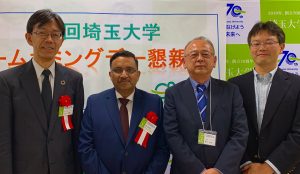
Dr. Amin is a proud alumni of this University (1998-2001). After the doctoral graduation, he remained associated with the Structural Mechanics and Dynamics Group (Structural Engineering Laboratory) of the department to conduct joint research, development, dissemination and student exchange activities in the common fields of interest. The duration of successful cooperation is now about to exceed a decade. The long understanding between him and the Structural Mechanics and Dynamics Group (Structural Engineering Laboratory) of Saitama University has led to signing five year Academic and Student Exchange Agreement between BUET and Saitama University, effective from April 2011. This agreement allows the two universities to exchange faculty, staff members and students for planning and implementation of collaborative research projects and educational programs conducive to the need of the time. Furthermore, the two universities will also exchange academic materials, publications and pertinent information for mutual benefit.
See further at: https://www.buet.ac.bd/web/#/details/59

The University of Tokyo
The University of Tokyo was established in 1877 as the first national university in Japan. As a leading research university, UTokyo offers courses in essentially all academic disciplines at both undergraduate and graduate levels and conducts research across the full spectrum of academic activity. The University aims to provide its students with a rich and varied academic environment that ensures opportunities for both intellectual development and the acquisition of professional knowledge and skills. To learn more about the University of Tokyo, please visit the pages below.
Osaka University
Osaka University, or Handai, is a public research university located in Osaka Prefecture, Japan. It was one of Imperial Universities in Japan, one of the Designated National University and selected as a Top Type university of Top Global University Project by the Japanese government.
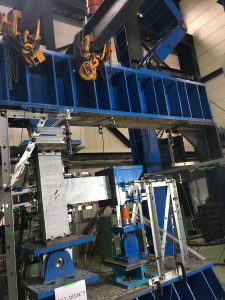
Tohoku University
In 1911, Vice Minister of Education Masataro Sawayanagi, moved to Sendai to become Tohoku University’s first president. Sawayanagi firmly believed that academic research should be integrated with education. He also believed that a university should not discriminate based on class or gender.
Following this principle, Tohoku University accepted graduates from technical and higher normal schools, and despite opposition from the government at that time, became Japan’s first university to admit female students in 1913.
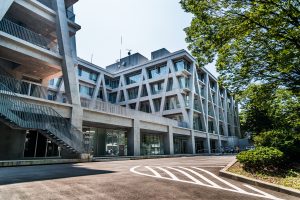
Daido University
The university began as the Daido Technical-Educational Foundation in 1939. In 1969, the school became the Daido Institute of Technology. The university traces its origin back to the companies founded by Momosuke Fukuzawa. These companies consist of the Great Consolidated Electric Power Company, Limited (current: Kansai Electric Power Company and Chubu Electric Power Co., Inc.), the Nisshinbo Industries, Toho Gas Co., Ltd., Daido Steel Co., Ltd., Toagosei and Nagoya Railroad Co., Ltd. (Meitetsu), etc. He had a concept of a research institute for industrial technician trainings. The president of Daido Steel, Yoshio Shimoide (a member of the Japanese Diet), was inspired by his concept. In January 1939, Daido Technical-Educational Foundation was established by Yoshio Simoide.

University of Asia Pacific
Faculty Members of University of Asia Pacific are closely working with the Research Team of Prof. Amin towards developing appropriate methodologies for assessment, maintenance, repair and strengthening of buildings and bridges.
Housing and Building Research Institute
Housing & Building Research Institute (HBRI) is now running under the general direction and superintendence of the affairs and business of the institute are vested into the Governing Council. The Director is the ex-officio member –Secretary of the Council and the Chief Executive officer of the institute. Over the years the institute has been able to build up necessary laboratory facilities for test/research works and recruit a good number of qualified engineers/architects/scientists with experience and training in home and abroad. Constant efforts of imparting higher education and training both in local and foreign to research personnel are being made and this is the keystone of R & D policies.
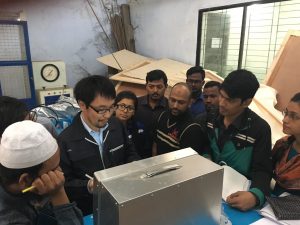
Jahangirnagar University
Jahangirnagar University accustomed as a fully residential public university established in 1970 has now 36 departments and Six Faculties along with Four institutes, with added than fifteen thousand students, and about Five hundred academics adherent to teaching and research. The sprawling arresting campus is anchored 30 kilometres from the basic Dhaka, able-bodied affiliated with a civic highway. The aboriginal assembly of Independent Bangladesh accepted the university its Charter in 1973 beneath which the university is getting operated.
The badge of the university bears the civic annual ‘white lily’ (Lilium condidu) with three petals belted by strips of a acceptable floral architecture with the name of the university in Bangla ensconcing in a semi-circle like a band of flowers.
University of Kassel, Germany
The University of Kassel, founded in 1970, is the one of the newer university in the state of Hesse, Germany. The university is in Kassel, and currently has about 18,035 students. There are more than 1,783 staff, including 304 professors and about 900 other academic staff and 1,100 technical and administrative staff. Source: UniKassel Website
Dr. Amin stayed a summer at the Institute of Mechanics of Department of Mechanical Engineering as a Visiting Professor. Professor Peter Haupt founded the study of Continuum Mechanics there in Kassel in 1989 and produced a number of successful researchers in this fundamental field who are now established across Germany.
Military Institute of Science and Technology, Dhaka
Establishment of a technical institution for Bangladesh Armed Forces had been a long desired need. It had been very strongly felt since 1980’s in view of growing demand for technical personnel in military service. In the absence of such an institution in the Armed Forces, the military demand for technocrats was being supplemented by nomination of military officers to undergo graduation and post graduation courses at Bangladesh University of Engineering & Technology (BUET), former Bangladesh Institutes of Technology (BIT) and other foreign technical institutes. MIST came into existence on 19 April 1998. It throbbed into breathing when the academic programme was launched on 31 January 1999 with the maiden batch of Civil Engineering (CE). Though the pioneer batches comprised only military students (session 2001-2002), civil students (both male and female) were admitted to various disciplines from the session 2002-2003.
Chittagong University of Engineering and Technology
Chittagong University of Engineering & Technology abbreviated as CUET, is one of the prominent and prestigious degree awarding institute in the engineering education of Bangladesh. This University was created out of Engineering College, Chittagong, that was established in 1968. The Engineering College , Chittagong , functioned as the Faculty of Engineering of the University of Chittagong. Though a Government Ordinance in 1986 the college was converted into an institution (BIT, Chittagong). Source: CUET Website
Dr. Amin is associated with the faculties of the Department of Civil Engineering for joint research and development activities.
Dhaka University of Engineering and Technology
Dhaka University of Engineering & Technology (DUET), Gazipur is one of the reputed universities for the study of Engineering in Bangladesh. The University originated in 1980 as a Faculty of Engineering under the University of Dhaka offering four years ‘ Bachelor degree in Civil ,Electrical and Electronic and Mechanical Engineering ‘ to help meet the growing need for advanced engineering education in Bangladesh. With new technologies appearing faster than developing countries can absorb them, the technology gap between developing and industrialized nations continue to widen at an alarming rate. A major reason for this widening gap is the lack of skilled engineers capable of integrating new technologies into existing, systems and networks. To alleviate this situation by educating engineers with the ability to plan, administer and manage the latest technologies, in June, 1986, under its name of Bangladesh Institute of Technology, Dhaka, the Institute became an autonomous institution empowered to award degrees.
Kawakin Core-Tech CO., Ltd.
Kawakin Core Tech Co. Ltd is actively participating the Research Team of Prof. Amin in BUET on exchange of technical ideas and know how for developing appropriate materials for constructing bridge bearings for Bangladesh. Maintenance of bearings and rehabilitation of bridges with new bearings are also being addressed.
University of Federal Armed Forces Munich, Germany
The Universitat der Bundeswehr Munchen (University of Federal Armed Forces Munich) was founded in 1973 with the aim of providing officers and officer candidates with a university education that would also prepare them for civilian careers. After all, most regular soldiers leave the Bundeswehr after 12 years. Since its founding, the number of students has been rising steadily: today there are around 3,700 registered students, including 360 women, 50 civilians, and 150 international students and officers. The Universitat der Bundeswehr Munchen is made up of the University and a College of Applied Sciences (Fachhochschule) and offers a total of 13 programs of study in 7 departments of the University and 3 departments of the College. The excellent scientific facilities allow high-level research that is competitive on an international scale. Source: UniBw Website
Dhaka University
On the first day of July 1921 the University of Dhaka opened its doors to students. In the beginning there were three faculties Arts, Sciences, and Law. These consisted of 12 departments Sanskrit and Bengali, English, Education, History, Arabic and Islamic Studies, Persian and Urdu, Philosophy, Economics and Politics, Physics, Chemistry, Mathematics, and Law. In the first academic year, the total number of students was 877. There were sixty teachers, including distinguished scholars of the humanities such as Haraprasad Sastri. F.H. Turner, Mohammad Shahidullah, G.H. Langley, Haridas Bhattacharya. Ramesh Chandra Majumder. A.F Rahman and Naresh Chandra Sengupta. Truly Dhaka University can be proud of them as well as its distinguished teachers of science. A few of them have been considered among the creators of modern science, and did much of their best work while teaching in Dhaka University. The name of Satyandranath Bose( Bose-Einstein Quantum Statistics fame) must be mentioned in this context.
In fact, as any student of Physics anywhere in the world knows. The universe consists of two types of fundamental particles, namely Fermion (obeying Enrico Fermi’s Statistics) and Boson (obeying Satyandranath Bose’s Statistics). The other physicists of international stature are KS. Krishnan (Dhaka University 1928-35) and S.R. Khastgir (Dhaka University 1931-48). The contributions of Gyanchandra Gosh and Mokarram Hossain Khundker in Chemistry. Quazi Motahar Hossain in Statistics, and Kamaluddin Ahmed in Biochemistry, Pharmacy & Nutrition Science, must also be mentioned. Source: DU Website
Dr. Amin is associated with the Department of Applied Chemistry and Chemical Engineering and cosupervise researchers at post graduate level.
JFe Steel Corporation
A bilateral agreement between JFe and BUET under the supervision of Prof. Amin is facilitating the implementation of a five year long Atmospheric Exposure Test at different locations of Bangladesh.
The objectives are as follows:
- To collect first hand data for airborne salt at different geographical locations of the country.
- To expose different grades of steel specimens including weathering steels to the actual environmental conditions and thereby to make direct comparisons between different grades of steel.
- Attempts are being made to make a comparative assessment of life cycle costs for different grades of ordinary steel and weathering steels at different geographical and climatological locations of Bangladesh.
After successful completion of this study, the results and conclusions will be presented in seminar and published in local and international journal/proceedings to form a basis for forming the future design approach in the country with this promising material. The outcome of the study will also be valuable to rationalize the existing corrosion protection approaches in bridges and exposed structural members made of ordinary steel. The data gathered from the study will also be useful for developing corrosion models across the country for different climatic conditions and its expected change over the time.

